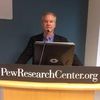Pentecostalization and pluralization stand out as the two major trends shaping the Latino religious landscape of the United States. The new Pew survey, for which I was a consultant, contains a treasure-trove of intriguing data on Latino religiosity, including such fascinating nuggets as St. Jude's (the patron saint of lost causes) status as the hands-down most popular Catholic saint. Here, however, I'd like to focus on the big picture of the dynamic and rapidly shifting Latino religious landscape.
The most salient trend, by far, is the impressive pluralization of Latino religiosity. On one hand, Catholicism is no longer the hegemonic faith among Latinos. Today only 55 percent identify as Catholic, a stunning decline from 67 percent just four years ago. If current trends continue, Latinos will no longer be majority Catholic by 2020 or so. This, of course, reflects shifts in the Latin American landscape where Uruguay and several Central American nations are no longer majority Catholic and even Brazil, home to the largest Catholic population on earth, faces the same fate within a decade or two.
Undoubtedly the driving force of pluralization is the rapid growth of Protestantism. 22 percent of Latinos now identify as Protestant, the great majority belonging to Pentecostal and Charismatic denominations. Reflecting further, Latin American influence, almost half of foreign-born Latinos were already Protestant in their native countries when they immigrated to the U.S.. As I've pointed out elsewhere Pentecostal denominations from Mexico, Brazil and Central America have followed their flock and founded vibrant churches in many U.S. cities with sizable immigrant communities. Their success has contributed to the other great trend, Pentecostalization, a theme to which I'll return shortly.
Mirroring patterns both in Latin America and the U.S., the third element of pluralization is the rapid growth of the religiously unaffiliated. 18 percent of Latinos, the majority of whom were raised Catholic, do not belong to any religious organization. The trend is most accentuated among Latinos under age 30. The majority of the unaffiliated, or nones, however, retain some degree of religious belief as only three percent of Latinos claim to be atheists or agnostics. The Pew survey wasn't able to explore this group in depth, but it's probably the case that a significant number of them engage in non-institutional practices, such as New Age, Latin American folk religion, and African diasporan faiths, such as Santeria.
Returning to the Latino Christian landscape, it now can be characterized as Pentecostalized, just like the Latin American one. The trend is most pronounced, of course, among Latino Protestants, among whom two-thirds practice a Pentecostal style of worship, including speaking in tongues, exorcism, and highly spirited services. Even more significant is the fact that a majority of Latino Catholics, 52 percent, are now Charismatics, who practice the same type of Spirit-centered Christianity as their Pentecostal brethren. This too reflects the hegemonic status of Charismatic Catholicism in Latin America, where the majority of parishioners in countries such as Brazil and Guatemala describe themselves as Charismatics. Indeed one of the great underreported facets of Pope Francis is his affinity for Charismatic practice.
In short, pluralization and Pentecostalization are the two great takeaways from the new Pew survey of the Latino religious landscape. I expect that both trends will continue apace in the near future as the competitive marketplace of faith continues to diversify throughout the Americas.
